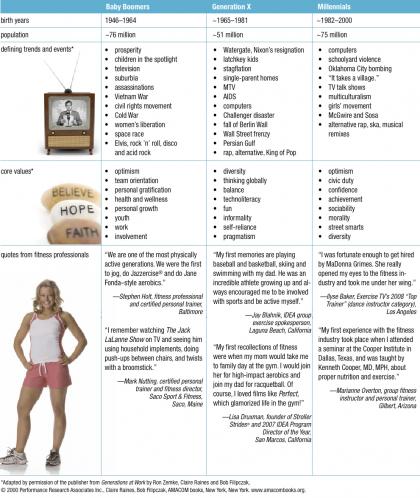Spanning The Generations
How Baby Boomers, Generation Xers and Millennials fit together.
Have you ever wondered why younger trainers are labeled as
having little loyalty to, or ownership of, the fitness business the way you did when you were their age? Or perhaps you are one of those younger trainers and you cannot figure out why your older colleagues frown when you tell them to “cheer up” and not take their jobs too seriously. Why does a group exercise instructor who has been teaching since the 1980s clash with the new director who feels strongly about moving away from the “old-school” styles of teaching? These differences in age, attitude and experience are part of the “generation gaps” that exist among Baby Boomer, Generation X and Millennial professionals.
Understanding the foundations and preferences of each generation can be the first step in bridging these gaps. While this article does not cover a comprehensive timeframe for all exercisers, it examines the following three influential generations within the fitness industry: Baby Boomers (1946–1964), Generation X (~1965–1981) and Millennials (~1982–2000) (there is far less consensus on the dates for Generation X and the Millennials than there is for the Baby Boomers). Read on to learn about communication principles, management strategies and education models that will help generations work together through their diversity, empowering them to become better leaders, managers and team players.
Talkin’ ’Bout My Generation
Since the early 1940s, every generation has had its core values and work ethic shaped by its fair share of political change, economic trends, cultural revolution and fitness movements. As each generation comes of age, it fights to free itself from the previous generation’s stereotypes and unintentionally impacts the subsequent generation (Howe & Strauss 2000). In the process, each generation finds areas where it successfully complements, yet also clashes with, other generations (see the sidebar “Snapshots of Each Generation”).
“People have a natural affinity and can very easily engage with someone within 8 years of their chronological age,” says Mark McCrindle, MA, a social researcher and director of McCrindle Research in Sydney, Australia. McCrindle studies generational diversity to help him foresee trends in business and society. He believes that by understanding the driving forces and expectations of each generation, everyone can learn how to relate with people even if they do not connect on the basis of chronological age. “Although a 32-year-old can connect naturally with a 24- and a 40-year-old person, with a little psychographic understanding (personality, values, attitudes, interest or lifestyles), he may also be able to identify with the 15- and 50-year-olds,” McCrindle suggests.
A generation is defined not simply by an age range or a birth year but also by the group’s shared beliefs and experiences and by its place in history (Howe & Strauss 2000). “The times shape us, the events, the experiences, the education systems, the values and the societal expectations,” McCrindle adds. It is important to have a basic understanding of generational distinctions, since they inform communication and management styles and also learning preferences.
Multiple Communication Styles
Most fitness professionals already use a variety of communication styles, since members and clients often have different backgrounds and fitness levels. Being generationally conscious is one more consideration that can provide advantages. Consider the following preferences when communicating with a colleague or addressing a multigenerational staff.
Baby Boomers appreciate face-to-face conversation, mainly because they view it as an opportunity to become socially and professionally acquainted. They are also willing to communicate via new technologies, like Facebook or Twitter, if it means staying relevant and part of the team. Boomers are generally pleased when asked for their feedback or consensus on decisions. They feel their experience brings value to a situation and are therefore willing to share their expertise with others. When communicating with Baby Boomers, use vehicles that reinforce these values and acknowledge the Boomers’ efforts within the group. They will see it as a sign of your investment in the relationship and/or business and, in turn, will go the extra mile to make a difference.
Gen Xers respond to succinct forms of communication. Since they are quite technoliterate, message content is more important than delivery mode. Tell them what they need to know, and trust that they will follow up appropriately. Work–life balance is a core value to Gen Xers; therefore, keep work-related correspondence to a minimum during their personal time. A typical Gen Xer might find staff meetings “a waste of time” if he believes he could be using his time more productively,
so keep interactions meaningful and concise. When communicating with Gen Xers, provide smart and genuine feedback or they will sense
insincerity and may dismiss your comments.
Millennials absolutely love to communicate, be it in-person, by phone, via e-mail, by text messaging or via online social networks like Facebook. Since they seem to be plugged in 24/7, they may expect the same kind of accessibility from others. So it is important to establish communication guidelines with Millennials early on. Because this is the latest generation to enter the workforce, constant feedback and supervision are well received. They may appear to be distracted or inattentive to your messages, but this does not mean they are not listening. Growing up in a media-overloaded world has taught Millennials to hyperfocus on information that is personally significant. Keep your conversations relevant, and Millennials are likely to listen.
When it comes to communication across all three generations, to say Millennials favor text messaging and Baby Boomers respond better to face-to-face interactions is rather a cliché. While these tendencies do exist, there may be ways to communicate that appeal to all generations. Tatiana Kolovou, MBA, a fitness professional and business communication lecturer at Indiana University, Bloomington, says, “In order to be a good communicator, you need to meet people in the style of communication that they prefer.” Having worked in fitness management and human resources, Kolovou has found that staff meetings are the best times to discuss these preferences. While some may prefer e-mail correspondence to direct phone calls, “the whole group needs to decide what the best form of communication is for them,” stresses Kolovou. “I don’t think managers should go out of their way to send one message three different ways.” However, she observes that “as technology becomes more prevalent in our culture, the savvier we become in using new technologies to communicate.”
Ultimately, fitness professionals must use their discretion in choosing the style of delivery for messages. “Our staff has a lot of noise in their lives, so to avoid being filtered out, you must make sure that all communication is necessary and concise,” says Krista Leopold, a fitness consultant and former group exercise manager from Charleston, South Carolina. Leopold uses both traditional and nontraditional forms of communication with her group exercise audience. While she sees e-mail and face time as the most effective forms of correspondence with her colleagues, she also uses blogging to address group fitness–related topics, such as choreography ideas, presentation skills and teaching tips (you can read her blog, “GroupFit Power,” at http://groupfitpower.com/blog).
Management Strategies
for Multigenerational Staff
One size does not always fit all when it comes to techniques for managing a diverse staff. This is apparent from the variety of books and resources written on management throughout the years. However, having a fundamental understanding of each generation’s work ethic and career expectations may provide additional awareness that you can layer into your management strategy.
Baby Boomers have a very strong work ethic. Sometimes
described as workaholics, they believe their careers are a big part of what defines them. In their work history, they have fought against authority, redefined their roles, manipulated the rules and played the political game in order to find professional and personal fulfillment in their jobs.
In response to the Baby Boomer work ethic, Gen Xers have developed a much more relaxed and flexible approach to work. They are extremely willing to work hard, but not at the expense of their work–life balance. They are typically known to avoid corporate politics, go around authority or turn situations in their favor. To Gen Xers, a job is just a job. They may love what they do, but they work to live—and not the other way around.
Millennials seem to have adopted the Baby Boomers’ teamwork ethic and the Gen Xers’ need for a flexible working environment. Often mature for their age, Millennials are incredibly goal-oriented and optimistic about achieving professional success. They thrive best under a structured work environment and (at least initially) may require more micromanagement than the other generations.
In Generations at Work (AMACOM 2000), Zemke, Raines and Filipczak suggest that managers can accommodate employee (and generational) differences by adopting a “sophisticated management style.” That is to say, managers should avoid a one-size-fits-all approach to leadership and be willing to tailor their supervision to the situation at hand—for instance, allowing
autonomy among Gen X employees while equally appealing to the “teamwork” strengths of Boomers and Millennials on staff. Ultimately, conflict across generations is inevitable in the workplace, but coupling management techniques with generational awareness may minimize it (see the sidebar “Management by Generation”).
Professional Growth and Education
Fitness professionals from each generation continue to increase the industry’s credibility by specializing in new areas, earning advanced degrees and pursuing various educational opportunities. “Back when I started, personal training wasn’t even considered a profession by anyone,” recalls Baby Boomer Stephen Holt of Baltimore, owner of www.babyboomerfitnessauthority
.com. “When I told people I was a personal trainer, the follow-up question was, ‘What’s your real job?’” Holt is now an
accomplished personal trainer, speaker and writer and was recognized as the 2006 ACE Personal Trainer of the Year.
At industry conventions and educational workshops, presenters are delivering more research-based material and raising the standards for quality instruction. Baby Boomer Janice Jaicks of Mesa, Arizona, is the founder and director of FitnessFest, the largest land and aqua conference in the Southwest, and has recognized the shift in balance between activity sessions and lecture classes at her events. “Back in my day, not everyone grew up having [exercise science] degrees. So, now we are always striving to learn more,” says Jaicks. She regularly includes high-caliber presenters like Len Kravitz, PhD, of the University of New Mexico, Albuquerque, on the conference schedule. Over the past decade Kravitz has also noticed more highly educated delegates attending his sessions. “[Fitness] professionals are reading more, taking classes, reading journals and studying their craft much more.”
The shift toward excellence and specialization is also present in colleges and universities across the nation. Over the last decade, Mesa Community College in Arizona—one of the largest 2-year institutions in the United States—has undergone many changes to its exercise science and physical education department in order to accommodate this trend. “Exercise science is so much more academically driven than it ever has been before,” notes Ann Stine, department chair. “This change has not only revolutionized our department but also opened many new doors for students developing careers in our arena.” The department has expanded to meet the technological demands of the Gen Xers and Millennials, as well as the educational needs of Baby Boomers returning for their secondary degrees and additional certifications.
As fitness professionals and exercise science students from each generation advance their knowledge, fellow fitness presenters and educators should also consider the learning preferences of Baby Boomers, Generation Xers and Millennials.
Baby Boomers generally shy away from lecture-style sessions. They prefer dialoguing and participating in team-oriented experiences during classes or workshops. Provide hands-on or role-playing activities in seminars, and allow time for follow-up group interactions. Baby Boomers tend to be visual learners and relate well to metaphors, so be descriptive, action oriented and direct when teaching.
Gen Xers tend to be more autonomous learners. They typically absorb information best when it is delivered in spontaneous, interactive environments. Provide multisensory activities and assignments that allow Gen Xers to process information on their own, and then suggest they report their findings back to the group or class. Gen Xers are very pragmatic and enjoy learning skills that transfer to other jobs, courses, formats and clubs.
Millennials prefer learning in a relaxed and fun atmosphere. Being übersmart is seen as “cool” for this generation, since Millennials are resourceful at finding information. Focus on developing their critical-thinking skills, and use technology (e.g., Web-based videos or downloadable handouts) to complement your sessions and classes. Millennials appreciate constant progress reports and learn best under a structured, supervised yet creative environment.
Bridging the
Generation Gap
While there may be significant differences among Baby Boomers, Generation Xers and Millennials, their distinctions are quite complementary to one another. In the coming decade, expect to see more partnerships develop between generations and more innovative trends evolve from these collaborations. As for what the future of fitness will look like for the incoming “Z” and “Alpha” generations, Mark McCrindle believes the answers come from understanding their parents: “[Gen Z and Gen Alpha] will be structured, educated, technological, widely experienced and reasonably conservative,” he predicts.
Listed below are three scenarios of conflict in the workplace. Although there are many ways to manage conflict, these suggestions consider
the generational tendencies of each employee and provide ways to mentor and motivate each one accordingly.
BABY BOOMER
Scenario #1:
The Baby Boomer Salesperson
Mike is a 54-year-old family guy who left his corporate job to pursue a career in the fitness and wellness industry. After his heart attack last year, he wanted to help people make smarter choices about their health. He eventually wants to open a fitness center, so this sales job is an opportunity for him to learn more about the industry. You have noticed he has not been meeting his quotas on selling new memberships.
Mentoring Mike
Baby Boomers are very knowledgeable and experienced, but they often need development in areas of strategic planning and budgeting (Zemke, Raines & Filipczak 2000). Fred Hoffman, MEd, 2007 IDEA Fitness Instructor of the Year and director of international services for The Club & Spa Synergy Group in Paris, France, recommends coaching Mike through sales procedures and equipping him with the training tools he needs to expand his skill set. “I would also turn the situation into a positive one by suggesting that this is a great learning experience for [Mike], since he will be faced with similar situations as a future club owner,” says Hoffman. Baby Boomers pride themselves on being lifelong learners. A message like this would resonate with Mike and keep him focused.
Motivating Mike
Make it a priority to get acquainted with Mike. Having a one-on-one conversation might be the best way to build a personal relationship. “I would reiterate that I value Mike as an employee and that I recognize his experience in the corporate world and what he brings to the company,” adds Hoffman. After Mike proves his worth, reward his efforts with public recognition and company perks.
GENERATION XER
Scenario #2:
The Gen X Group Fitness Instructor
Sally is a 37-year-old group fitness instructor who has been teaching since she was a freshman in college. She teaches all formats and puts terrific energy into delivering creative classes. Despite her recent pay increase, you receive an e-mail from Sally demanding another raise. She claims the younger instructors on staff are “more interested in being social than teaching effectively” and feels the need to be appropriately compensated.
Mentoring Sally
“Sally’s request for another raise might be more closely tied to her hope for recognition than to a hope for a bit more money,” says Amanda Vogel, MA, fitness instructor, IDEA presenter and former program director in Vancouver, British Columbia. The best way to coach Gen Xers is to ask them to take responsibility for their own issues. Ask Sally what she might want to do and offer ways to resolve her frustrations. Gen Xers enjoy doing lots of projects and prioritizing them in their own way. “One way to handle this scenario is to put Sally ‘on the inside’ of group exercise management by inviting her to mentor one or more of the younger instructors,” suggests Vogel. “The mentoring arrangement recognizes Sally as an instructor who has a strong enough skill set, knowledge base and teaching repertoire to lead other instructors.”
Motivating Sally
Offer Gen Xers the freedom to develop transferable skills and pursue new interests at work. “You could frame mentoring as a chance for Sally to further develop her teaching, coaching and mentoring skills,” says Vogel, who also suggests letting Sally set the parameters of the mentoring arrangement as she sees fit. Gen Xers like to feel as if they have control over their own work, and this opportunity could increase her job satisfaction. “Trust her self-reliance and her ability to take the reins,” adds Vogel.
Scenario #3:
The Millennial Personal Trainer
Josh is a 22-year-old personal trainer who has been training at your club for the past 7 months. Like many his age, he is gaining training experience while pursuing a kinesiology degree in college. You notice that he spends time texting between sessions and socializing with clients instead of focusing more effectively on training.
Mentoring Josh
“[With Millennials, their] social network is never far away, due to technology, and they don’t always initially recognize the boundaries of what’s appropriate,” says Chris Arterberry, MS, associate director of fitness and wellness at DePaul University in Chicago. Millennials need to develop their work skills, so it is important to budget time for orienting Josh into the work environment. Help him set personal goals, and discuss the expectations of the job (i.e., address the texting/socialization policy).
Motivating Josh
Millennials feel it is “hip” to be smart. Provide plenty of opportunities for them to explore their creativity and continue their education. “There’s a view that [Millennials] were coddled during their upbringing and don’t do well with direct communication,” says Arterberry. “So they may bristle at critical-thinking co-workers who directly question the Millennials’ creative ideas.” This could be why mentorship programs are effective and why feedback and structure are important. Being mentored will resonate with Millennials because they are motivated by opportunities to work with other creative people.
Fred Hoffman, Amanda Vogel and Biray Alsac are featured panelists in session #474, “Managing a Multigenerational Staff,” at the 2009 IDEA World Fitness Convention™ in Anaheim, California.
References
Croker, R. 2007. The Boomer Century, 1946-2046: How America’s Most Influential Generation Changed Everything. New York: Springboard Press.
Gravett, L., & Throckmorton, R. 2007. Bridging the Generation Gap: How to Get Radio Babies, Boomers, Gen Xers, and Gen Yers to Work Together and Achieve More. Franklin Lakes, NJ: Career Press.
Howe, N., & Strauss, W. 1993. 13th Gen: Abort, Retry, Ignore, Fail? New York: Vintage.
Howe, N., & Strauss, W. 2000. Millennials Rising: The Next Great Generation. New York: Vintage.
Lancaster, L.C., & Stillman, D. 2002. When Generations Collide. New York: HarperCollins.
McCrindle, M. The ABC of XYZ: Generational Diversity at Work.www.quayappoinments.com.au/email/040213/
images/generational_diversity_at_work.pdf; retrieved Mar. 23, 2009.
Oblinger, D. 2003. Boomers, Gen Xers, Millennials: Understanding the New Students. http://net.educause.edu/
ir/library/pdf/erm0342.pdf; retrieved Mar. 23, 2009.
Zemke, R., Raines, C., & Filipczak, B. 2000. Generations at Work: Managing the Clash of Veterans, Boomers, Xers, and Nexters in Your Workplace. New York: AMACOM.
Biray Alsac, MS
Biray Alsac, MS, is the owner of FITTmaxx Institute, a consulting company for health organizations and fitness/wellness professionals interested in learning how to integrate Web-based tools and interactive technologies (exergames) into their programming. She holds a masterÔÇÖs degree in exercise and wellness. Certification: ACE Education provider for: ACE






